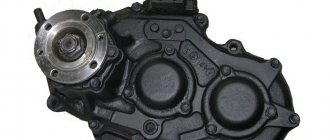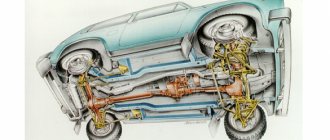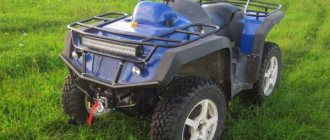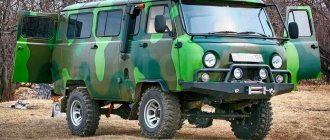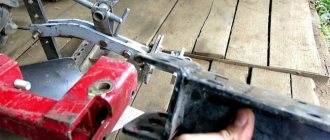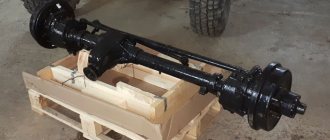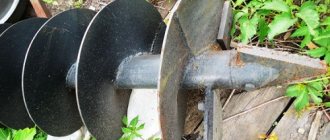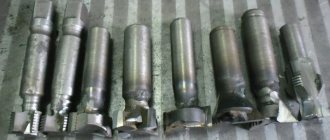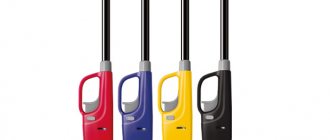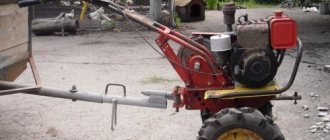Transfer case UAZ Bukhanka
The UAZ-452 was originally created for the Soviet armed forces as a medical service vehicle, where it was therefore dubbed the “tablet” (the civilian nickname is “loaf”). Therefore, the design of the mechanisms, including the transfer case, is simplified as much as possible.
During operation, the entire transmission system is unpretentious, which is confirmed by half a century of practice. The only recommendation from the manufacturer is to periodically check the oil level and check the fasteners.
In addition, if necessary, the front linkages should be adjusted and the lever axles should be lubricated on a preventive basis. This mechanical unit, including bearings, does not require any further maintenance or adjustment.
Selection of spare parts
In general, I decided to abandon boosting the GAZ M-20 engine and install the Volga GAZ-21 engine on my GAZ-69.
Slowly, I found a 4-speed gearbox from a UAZ, and then a transfer case from a Bukhanka. I couldn’t find the plate from the UAZ-469B, which is placed between the gearbox and the steering wheel. However, I came across the same one from Bukhanka, but it was a little narrower than the UAZ one. Also, I found four engine mounting mounts from UAZ or GAZ-51, because... they were practically the same. I took four spare sheet metal plates and adjusted the large holes of the engine mounts to them. In a word, I assembled everything and just waited for some unit to fail.
Device and how it works
The transfer case is a mechanism located in a separate housing made of gray cast iron. The assembly is divided vertically into a crankcase and a cover, which are connected by bolts. Both halves undergo joint processing, so it is impossible to install a part from another gearbox. The crankcase has a separate hatch for installing a power take-off. The oil-filled unit with the parking brake drum installed weighs 37 kg.
The transfer gearbox will only work correctly if it is correctly centered on the gearbox housing. For this, a 2-row angular contact bearing and a steel cylindrical cup are used. The gearbox shafts are mounted on ball and roller bearings, secured with nuts and retaining rings, respectively. The output shafts pass through sealing seals installed in the covers.
The drive shaft of the unit is the driven axis of the gearbox, which is equipped with a splined tip on which the gear is located. This part has 2 positions that allow you to get forward and reduced speeds. The shift drive is equipped with a special fuse that prevents the low range from starting until the front wheel drive is connected.
When the gear is connected to the gear wheel of the rear axle drive shaft, direct transmission is ensured. The gearbox device includes a special lever that allows you to move the gear to the side, engaging it with the gear of the intermediate shaft. In this position, the rotation speed of the driveshafts of the axle drives is reduced.
The design of the transfer gearbox has a movable gear wheel mounted on the middle shaft and controlled by a separate lever. This gear provides connection to the front wheel drive. When the gear is disengaged, the gear continues to rotate as it remains in contact with the rear axle drive gear. This operating principle is necessary to spray the oil in the crankcase.
The plant produced several modifications of the transfer gearbox, which differ in the module of installed gears. Because of this, the gear ratio changed - instead of 1.94 it became 1.47. It is possible to remake the old-style transfer case by replacing gears, since the housing design has remained unchanged.
On some cars there is an imported Hyundai Dymos transfer case (Dymos) with electrical control. The unit weighs 32.4 kg, provides direct and low gears (gear ratio 2.542). The unit is equipped with a controller that diagnoses the box and records error codes. The mechanical part of the imported box is very different from the Russian counterpart - instead of gears, a chain drive is used.
How to use
To change speeds, a lever is used that has 3 positions:
- extreme anterior, corresponding to direct transmission;
- average, at which the box is turned off;
- extreme rear to enable the lower row.
Before engaging a downshift, you must activate the front axle drive (using a separate lever). The switching diagram is printed on a special plate, which is attached to the instrument panel. The position of the control levers is slightly different on different UAZ models, but the far handle is always used to control the drive of the front wheels.
Before you start using the transfer case on your UAZ, you should carefully read the instructions. The low range can only be engaged with the clutch open and after the vehicle has come to a complete stop.
When using a Dymos box, switching is performed by a rotary washer having 3 positions:
- rear wheel drive only (2H);
- connection of all-wheel drive and direct transmission (4H);
- lower row and torque transmission to both axles (4L).
Switching transfer case UAZ Hunter
The transfer case is controlled and activated from the driver's cab, remotely. To do this, the user uses the levers located on the right side in relation to him. It is noteworthy that the machine, depending on the installed configuration, uses both single-lever and double-lever gearbox control designs.
The inclusion of a lower gear by an activating mechanism with one lever is accompanied by an independent shift of the lever at the end point, under the influence of a spring element, to the left side (towards the driver).
Transfer case shift lever positions:
The procedure for turning off a lower gear is accompanied by a preliminary shift of the lever to the right until it stops (in the direction of travel of the car). After which the lever moves to the zero position, forward in the direction of movement of the machine.
When working with a mechanism that controls the transfer case with two levers, take into account that the top switch drives the front pair of wheels. Device positions: first (wheel set on), second (wheel set off). The transfer case is controlled by three positions: first (main gear is working), second (zero position), third (low gear is activated).
IMPORTANT!: To prevent breakage of the transfer case gear teeth when switching gears, you can activate and deactivate the device (direct and low gear) only after the machine has completely stopped.
UAZ 469 / Happiness In Darkness › Logbook › Restoration, assembly - Gearbox repair part 18
The bolts securing the forks on the gearbox cover turned out to be slightly unscrewed, i.e. spun by hand. Tightened the bolts:
Put the gearbox cover in place:
Turn on the 4th speed and look at the position of the fork from the side of the gearshift knob:
We look at the position of the 3-4 gear clutch and the location of the crackers:
We look at the position of the fork from the inside of the gearbox cover:
Everything seems to be normal, but the 4th speed can be turned on “Further”...
Turn on the 4th speed “Next” and look at the position of the fork from the side of the gearshift knob:
We look at the position of the 3-4 gear clutch and the location of the crackers when turning on the 4th speed “Next”:
As you can see, the coupling has also moved further, because nothing limits it, and the balls of crackers began to peek out from the clutch... This can cause the crackers to come out, eat the synchronizer ring and jam the 4th gear.
We look at the position of the fork from the inside of the gearbox cover when turning on the 4th speed “Next”:
We need to solve the problem, now I think I understand that I read somewhere about washers limiting the travel of the fork, now it’s clear where to put them...
We look at the gap that allows the plug to turn on further:
It turns out 6 mm
. You need to select a washer of the required diameter, 6 mm thick, in order to prevent the plug from turning on “Next”.
Let's disassemble the mechanism for moving the 3rd and 4th gear forks:
Rear axle drive shaft
What does the UAZ transfer case consist of, what are its features? This shaft is mounted on two ball bearings. To protect the element from axial movements, it is held in place by a rear bearing with a thrust ring and a cover. A gear is attached to the front of the shaft. Its inner crown has slots. The function of this gear is to drive the front drive axle. Internal splines are required to engage direct transmission in the transfer case.
A screw-type gear is also installed on the splines between the bearings. It serves as a drive for the speedometer. The rear part of the shaft is connected to the cardan shaft using a nut with a conical protrusion through a flange. If you tighten this nut, its conical protrusion will bend into one of the grooves that are cut into the threads and stop.
Causes of breakdowns
As a rule, the need to replace the main components of a gearbox arises due to their natural wear and tear.
Causes of gearbox breakdowns
The main reason for oil leakage from the gearbox is the presence of an increased level of fuel in the system. For UAZ gearboxes, you should use high-quality oil. If the liquid is not of the proper quality, this may cause characteristic noises from the box. When the synchronizer or its parts wear out, it is always difficult to change gears
You should also pay attention to the details of the switching mechanism. When gear teeth are deformed, gears often switch off automatically
Article on the topic: ZF gearbox repair
Replacing the bearing and oil seal
The design of the transfer case allows the replacement of the rear wheel drive shaft seal without dismantling the unit. To do this, you need to disconnect the driveshaft and remove the parking brake mechanism. The old oil seal is removed using a slotted screwdriver.
Replacing bearings without removing the gearbox is not recommended, since the parts are installed with interference. If the bearings are removed from their housings by hand, the gear housing must be replaced with a new one.
The other day I received a second set of races and washers (according to Tough drawings) for installing a double-row bearing on the front shaft of the RK. In connection with this, the question arose about quickly replacing the bearing without removing the transfer case. The operation is not complicated - but maybe it will help someone not to waste time thinking and running from the pit and back. The tools are standard - heads, wrenches, and preferably a cardan. So:
1. Remove the front cardan, turn on the lock and loosen/unscrew the nut of the front shaft shank.
2. Remove the plastic cover of the control levers in the passenger compartment to gain access to the nuts of the locking lever cover.
3. Disconnect the locking switch sensor and unscrew the four nuts of the locking lever cover. We lift it to make sure that the gasket/sealant does not hold it - it will be inconvenient to tear it out of the hole!
4. Drain the oil from the reservoir into a clean container
Read more: Land Rover Defender 1998
5. Unscrew the nuts securing the front cover of the RC and pull it out from the studs towards you. The shaft with the CV cover passes under the traverse of the third gearbox support, but the locking lever is hidden in the tunnel. As a result, we hold the front cover of the RC with one hand, and with the other we hold the lever so that it does not fall on our heads and carefully carry everything to the workbench/clean floor. ATTENTION – do not lose the spring and ball of the locking rod retainer!
6. Next, we change the bearing (I won’t describe the process - everything is done as in the manual) with a new one or with a cage - my case.
Now all this needs to be installed back. To do this, you need to remove the locking lever and assemble everything without it:
7. Use a screwdriver to pry up the washer holding the axis of the locking lever and remove/knock out this very axis (it comes out with difficulty).
8. We wipe everything with a rag soaked in kerosene/diesel oil and make sure that the axle enters/exits freely - by hand - if not, then you need to do this - neither a hammer nor a pry bar can help.
9. Next, carefully apply the sealant (before this, be sure to remove traces of the old one) onto the cover of the locking lever and install it in place (without the lever).
10. We put the RC in neutral, and turn on the lock on the front cover of the RC so that the clutch does not fall out. We climb into the hole with the assembled RC cover and, having applied sealant to it, put it in place; for me it stopped 5 mm to the end and refused to go any further. I put the front flange on the shaft and rotating the rear and front flanges squeezed them towards each other - click - the cover sat down! The flange can be removed - without it it is more convenient to install the lever.
11. Tighten the front cover nuts.
12. Install the lever (not forgetting about the axle lock washer and the metal gasket between the lever and the locking rod - it probably serves to dampen vibrations from the rod to the lever).
13. Next, we reconnect the lock activation sensor and turn on the lock.
14. We put on the flange and tighten the nut with the proper torque.
15. Well, then - we install the cardan, the lever casing - we check EVERYTHING! - ATTENTION! Don't forget to refill the oil!
PS If I missed something, don’t be angry – I’m not particularly good at writing, but I think I didn’t forget to point out anything fatal.
Dismantling the transfer case without dismantling the gearbox.
Dismantling the transfer case without dismantling the gearbox.
Post by zam79 » Wed Mar 05, 2008 17:14
Post by Alexander72 » Wed Mar 05, 2008 17:37
Re: Dismantling the transfer case without dismantling the gearbox.
Post by NewRise » Wed Mar 05, 2008 17:49
Post by zam79 » Wed Mar 05, 2008 17:59
Post by Toha3580 » Thu Mar 06, 2008 12:48
Isn't this the neutral sensor? can be used to connect autorun. This topic just popped up somewhere. that's when I remembered
Regarding the removal of the RC, removing it is not a problem, but putting it back is a problem. I don’t know if there are any centering bushings there, but I remember a long time ago someone wrote (maybe not here) that they changed the AC at the service center, so it was shifted a little to the side from its original position, so it either stopped turning on, or it went crazy something. This may be nonsense, but pay attention to this when you bet
Post by zam79 » Thu Mar 06, 2008 14:12
I'm a lamer, my whole family is lamer. although I’m a bit of a tinkerer with computers. How can you put a photo directly in the body of the message??
seems to be the correct link to a photo of an unknown device..
Source
Causes and troubleshooting
The design of the UAZ gearbox is reliable, trouble-free and durable. However, problems with equipment occur due to errors in use and violation of established regulations.
| Source and symptoms | What to do |
| Exceeding the permissible hum level of a working device | |
| Erasing the gear teeth of the box. | Replace worn out box items. |
| Weak fastening of the transfer case to the box, or reduced fixation of the bearing caps. | Tighten the fasteners, if the symptom recurs, dismantle the product and eliminate the defect. |
| Bearings are worn out. | Replace erased items. |
| Saturation of the working fluid with wear products from the box. | Remove the pan, wash it, change the oil. |
| Incorrect oil used, low fluid filling level. | Change the working fluid, set the desired level. |
| Carrying out repairs to replace gears, without selecting a product to minimize noise. | Check the gears for noise and replace them with the required ones. |
| Switching steps is difficult | |
| Different wheel wear. | Replace with wheels with the same tread and equalize the internal pressure. |
| The joints of the longitudinal projections of the main and the mediator shaft are jammed. | Sand the areas with burrs; if that doesn’t help, change the elements. |
| The drive gear has damage on the teeth of the small ring. The shift fork rod is bent. | Sand the damaged areas, straighten the rod, if that doesn’t help, change the element. |
| The switch rods are stuck on the axle. | Separate the parts, clean the axles and pipes, coat with lubricant, and connect the product again. |
| Spontaneous speed shutdown | |
| Erasing the teeth of the gears of the box. | Replace worn out box items. |
| The box bearings are worn out. | Replace worn box elements. |
| A large gap in the articulation of the shaft and gear. | Select the gear according to the size of the longitudinal protrusions. |
| The transmission is unable to engage because the mechanism is bent or there is damage to the gears and cylinders. | Correct bends, sand damage, or replace parts. |
| Poor functioning of the locking mechanism, loss of elasticity of the spring mechanism, abrasion. | Replace erased items. |
| Leakage of working fluid | |
| Violation of the integrity of the sealing elements of the pan, bearing caps, and the transfer case’s articulation with the gearbox. | Replace sealing elements. |
| Weak fastening of the cover, bearing, pan, joints. | Tighten connections. |
| Violation of the integrity of the shaft seals. | Replace the damaged element. |
| Violation of the integrity of the tray or lid. | Replace the damaged element. |
| The plugs of the switching rods, switching rods, and the plugs of the front bearing of the middle shaft fall out or are broken. | Change the plugs. |
| Bearings are damaged | |
| No, or a small amount of lubricant. | Change or add fluid. |
| Demolition of cages and bearing rings due to abrasive. | Change the elements, dismantle and wash the pan, change the working fluid. |
| Excessive shaft bearing friction. | Disconnect the element, clean the product, and coat it with lubricant before reassembling. |
Unit repair and maintenance
Signals for repairs can be:
- Oil leak.
- Increased noise and vibration.
- Difficulty switching from one position to another.
- Spontaneous loss of the switched on operating mode.
Although often, to fix problems, it is enough to just adjust the fasteners or lubricate problem areas and points. If this does not help, the car must be driven into an inspection pit or overpass, after which technological operations must be carried out in strict sequence.
Repair stages:
- dismantling and disassembling the box;
- failure detection;
- elimination of the causes of malfunctions (replacement or restoration of parts);
- assembly, installation in a regular place, adjustment.
Transfer case maintenance
With constant use of the vehicle, the transfer case of the UAZ “Patriot” and any other model requires careful maintenance.
The standard part care process includes:
- visual inspection for the presence of lubricant leaks in places where rubber seals and gaskets are located;
- checking the fasteners that attach the gearbox to the gearbox and tightening the propeller shaft bolts;
- Changing the oil in the UAZ transfer case.
Car maintenance requires simultaneously changing the oil in the gearbox and transfer case of the UAZ Patriot. The frequency of replacement is determined independently, taking into account the manufacturer’s recommendations. Regardless of which transfer case is installed on the UAZ, the Ulyanovsk Automobile Plant recommends changing the oil every 35-40 thousand kilometers.
When regularly operating a vehicle in off-road conditions, the oil must be changed more often, since the transfer case and the entire transmission of such a vehicle are subject to increased loads.
Without careful maintenance and care, the transfer case may fail, after which the driver will have to replace the UAZ RK with a new one.
Possible breakdowns and diagnostics
Below is a description of the main breakdowns of transfer gearboxes:
- Damage or natural wear of rubber seals, leading to oil leakage from the crankcase. Gears operating under oil starvation conditions wear out. Metal particles that get into the bearings and the contact patch between the teeth accelerate the wear of the rubbing surfaces. Oil leakage is noticeable upon visual inspection of the transfer case.
- Mechanical damage to parts affects the noise level of the unit. Damaged gears spontaneously disengage. In this case, there may be no oil leaks.
- The destruction of the rolling bearing leads to the appearance of crunching metallic sounds; With severe wear, the shafts become jammed.
- The Dymos transfer gearbox is equipped with an electronic controller that displays information about a malfunction. When the 4H and 4L indicators and the 4WD Check sign turn on at the same time, it is necessary to diagnose the unit. Increased noise during operation indicates stretching of the metal chain transmitting torque.
Checking handouts
The advantage of a torque impulse distributing device is that the device requires minimal intervention and maintenance. Manipulation consists of checking the level and changing the oil, inspecting the joints for damage. Before working with the box, the product is cleaned. This helps detect hidden cracks and leaks. If such symptoms are found, they find out the cause of this phenomenon. Defective parts are usually replaced, such as seals and seals.
After cleaning and visually inspecting the dispenser surface, check the product's lubricant level. If there is not enough liquid, add substance. At the same time, check the oil in the gearbox; the value corresponds to the lower edge of the filler hole. If the fluid level in the transfer case is low, but at the same time high in the transmission, there is no need to add it, since the total amount of fluid has not changed.
A detailed inspection of the box includes disassembling the product. After washing and air drying, the area is checked. The pan and plugs are checked for cracks and chips. Seals and gaskets have been replaced with new ones.
Changing the oil in the UAZ gearbox:
They check whether the condition of the working parts on the shafts and grooves is normal, so that the teeth of the gears do not wear out or become scratched. Even if the damage is minor, the products must be replaced. Attention is paid to the bearings; abrasion of the ring tracks is not allowed. Cages, spheres, rollers, etc. are also checked. Gaps, fragments, impacts, uneven movement are a signal to change the product.
READ Rear lights of VAZ 2107 do not light up
Cranks and forks become stuck and deformed, spring elements lose elasticity, and products change. In addition, you should carefully consider the issue of switching when finding the UAZ levers and handouts. The clutch teeth are checked for damage. The weak link of the differential is the satellite. Small defects force the product to be ground or, in the worst case, changed.
general information
First, let's figure out what this part is and why it is needed? The transfer case is a unit that is responsible for distributing torque from the car’s engine to multiple drive mechanisms, and they quite often increase the number of gears in the transmission.
Some cars of this brand are equipped with an improved small-module box. In such a box, the teeth of the gears of the front and rear axles, the teeth of the rims of the drive rollers of the front and rear axles are made with a module of 2.5 mm (in other transfer cases - 3.5 mm). The transfer cases can be replaced with each other, and in addition, they are exactly the same in appearance.
Maintenance
Like any other car part, the transfer case also requires some maintenance. So, the necessary maintenance:
Check the oil level regularly to ensure timely replacement.
Please note that during vehicle operation, the oil level in the gearbox may drop by up to 8 mm relative to the lower edge of the filler hole, as well as its increase. In this case, there is no need to equalize the oil level, because the total volume of oil contributes to the normal functioning of both units. Check all fastenings regularly; In case of oil leakage, it is necessary to detect and eliminate the cause, namely, replace failed cuffs, plugs, gaskets, etc.;
Common problems and causes of their occurrence
Transfer case UAZ Patriot
Possible problems with the gearbox of a UAZ Patriot:
- The teeth of the gears are broken;
- Oil leaks through the seals;
- The distributors are humming, the gearbox of the UAZ Patriot is noisy;
- Bearings are worn out or destroyed;
- The downshift switches off automatically.
Now let's look at the causes of problems with the UAZ Patriot transfer case:
- The transfer case is poorly screwed on;
- The UAZ Patriot engine mount is broken;
- Low quality of parts, namely oil seals and bearings;
- Long-term driving and use of incorrectly inflated wheels;
- Long-term driving with a connected front axle;
- The transfer case of the UAZ Patriot car is worn out. Quite often this happens due to low quality or lack of the required amount of gear oil;
- Huge overloads during operation either due to necessity or little driving experience;
- Untimely replacement of transmission oil;
- The driveshaft is beating. Quite often this happens due to poor quality of the shaft, damage to the crosspieces, destruction of the outboard bearing or untimely injection;
- Use with a brand of gear oil that does not correspond to the intended purpose or season;
- There is no lubrication in the spline joint of the propeller shaft;
- Poor quality tuning, namely the stroke and length of the driveshaft does not correspond to the changes made;
- Not very high-quality tuning, namely incorrect transmission ratios.
Some tips on the topic of the UAZ Patriot transfer case:
Please note that the front axle must always be switched off, unless absolutely necessary; The transfer case is not equipped with a center differential, and this has a significant impact on its life when the front axle is connected constantly or for a sufficiently long time.
Removing and disassembling the transfer case
Removing the transfer case
We work together on an inspection ditch or lift.
Drain the oil from the transfer case (see Changing the oil).
Remove the left and right floor linings (see Removing the parking brake drive mechanism). Disconnect the speedometer drive from the transfer case (see Replacing the speedometer drive). Remove the front and rear driveshafts (see Removing the driveshaft).
Using a 13mm wrench, unscrew the two nuts securing the exhaust pipe clamp to the gearbox bracket.
Using a 12mm wrench, unscrew the two bracket mounting bolts...
Disconnect the wire ends from the parking brake warning switch.
Using two 19mm wrenches, loosen the tightening of the switch adjusting nuts.
Remove the rubber buffer of the switch.
Unscrew the nut and remove the switch.
We disconnect the adjusting fork from the parking brake lever and, having unscrewed two bolts, remove the brake lever along with the rods (see Removing the parking brake drive mechanism).
Holding the eight crossmember mounting bolts with a “17” wrench, unscrew their nuts with a “19” head.
Using a 17mm wrench, unscrew the two bolts securing the transfer case to the gearbox on the right side...
...and with a 19mm wrench, use the two nuts on the left side.
Tapping with a hammer through a wooden block..
...and, pressing with a mounting spatula, remove the transfer case.
Remove the spacer washer.
Install the transfer case in reverse order:
We replace the sealing gasket between the transfer case and the gearbox, applying a layer of sealant to the gasket. We engage direct transmission in the transfer case with a lever, guiding the drive gear by hand through the hole in the crankcase. For ease of installation:
Using a 12mm wrench, unscrew the four bolts securing the switching mechanism.
Install the intermediate washer. We use sealant to “glue” the sealing gasket to the gearbox. By turning the parking brake drum, we put the transfer case on the studs and the secondary shaft of the gearbox. We tighten the bolts and nuts securing the transfer case. By evenly tightening the bolts and nuts, we ensure that the outer ring of the bearing is pressed into the transfer case socket and that the units fit tightly together. Install the removed parts in reverse order.
Pour transmission oil into the transfer case (see Changing the oil).
Disassembling the transfer case
We remove the transfer case (see Removing the transfer case), clean it from the outside of dirt and place it on a workbench. Pour about 0.5 liters of kerosene or diesel fuel into the crankcase and rinse the box, intensively rotating the shafts. Drain the liquid. Remove the speedometer drive (see Replacing the speedometer drive).
How to fill oil into transfer case
Procedure for changing oil in a Daimos type box:
- Warm up the fluid in the transfer gearbox by driving the car for 15-20 km. Replacement is carried out after 45 thousand km or once every 2 years.
- Wipe the box housing around the filler and drain holes.
- Place a container designed for 2-2.5 liters of liquid.
- Unscrew both plugs and drain the oil from the crankcase.
- Wait 10-15 for complete drainage, replace the plug with a new O-ring.
- Fill the crankcase with 1.8 liters of fresh 75W-85 API GL-4 oil through the filler hole.
- Close the hole with a plug with a new O-ring.
Repairing transfer case: do-it-yourself UAZ car
The transfer case helps distribute the torque from the engine to several drives at the same time.
You can repair the UAZ transfer case yourself; it is not as difficult as it seems at first glance, and you will also be able to save on paying for the services of a car service technician.
Causes of transfer case malfunction
This is the unit
Before starting repairs, of course, it is necessary to find out the cause of the malfunction.
- There was a loud noise in the transfer case. This could be the result of loose nuts that connect the transfer case to the transmission or loose bolts on the bearing caps. The list of reasons includes wear of the bearings or gears themselves, poor-quality or unsuitable oil, or its low level.
- Gear selection and shifting work poorly. This usually occurs due to the clutch seizing on the splines of the front drive hub or shafts. Or, alternatively, the gear selector is deformed.
- The transmission switches off spontaneously while the vehicle is moving. The gear teeth may be worn. Also, shutdown may be affected by an increase in the gap in the spline connection or wear of the clamp parts.
- Oil leaks. Often the problem is caused by wear or mechanical damage to the sealing gaskets, loosening of the nuts on the cover, wear of the seals or sealing rings of the actuator rods.
The solution to all these problems is either repair or replacement of faulty parts. In some cases, it will be enough to just tighten the nuts or add oil.
Stages and main points of repair
Repair of the transfer case takes place in several stages.
- Removing and disassembling the box.
- Troubleshooting.
- Eliminate these faults by replacing the part or repairing it.
- Assembling and installing the box in place.
To remove the box and disassemble the UAZ 469 transfer case, you need to proceed as follows:
- drive the car into the inspection hole;
- lower the parking brake lever and put the gear levers and transfer case in neutral;
- then the casing and lining are unscrewed one by one, the handles and covers are removed, and all wires are disconnected.
Before you start disassembling the device, you need to wash it and drain all the oil. For ease of disassembly, it is better to use a special stand where the transfer case can be secured.
When disassembling the differential, it is advisable to mark on its body the relative positions of the driven gear mounting bolts, so that later it will be easier to put everything back in place.
Finding faulty parts, repairing and replacing them
Before inspection, all parts must be cleaned with a brush and rinsed.
- Oil seals. They are considered unusable if the wear of their working edge exceeds 1 mm. For any minor damage, the part is replaced with a new one.
- Covers and crankcase. Cracks, dents, chips - all this is a good reason to replace it with new parts. However, for very minor damage, you can get by with simply cleaning the damaged area with a file.
- Gears. Worn teeth and their chipping are a reason to replace the part. Otherwise, this will lead to deterioration in handling on difficult road sections and increased load on the engine.
- Shafts. For these devices, the first thing to check for wear is the splines, working surface and threads. By installing the front and rear drive shafts on the prisms and turning them by hand, as well as the drive shaft, we check the runout of the end part, which should not exceed a tenth of a millimeter.
- Bearings. Check for scratches and other damage to the surface. Any cracks or chips indicate the need to replace the bearing. The work of the part must be flawless. It is important that its turns are carried out without jamming or extraneous sounds. Otherwise, the bearing is unusable and must be replaced.
- Clutch and hub. May have nicks, burrs and burrs, which can only be cleaned with a file. If the ends of the teeth on the coupling are damaged or deformed, the part must be replaced.
- Differential. In case of minor damage to the surface of the satellite axis, they can be sanded with fine-grained sandpaper. If the damage is significant, the axle will have to be replaced.
The UAZ transfer case is assembled in the reverse order to the one in which it was disassembled, and before installing the unit in place, its operation is checked on the stand. The function must be flawless, the assembly must be correct, and it is important that no oil leaks. Tests are carried out first in a higher gear, then in a lower gear.
Engines installed on GAZ-69
Soon the UAZ-469B car went into production, and since
Since the new car was much more dynamic and comfortable than previous models, most GAZ-69 owners began installing UAZ and Volgov engines in their cars. However, among the adherents of more powerful engines, there were also those who were partial to the engine from the UAZ-450. Due to the fact that it had a piston with a diameter of 88 mm, the engine power reached 62 hp.
Engine UAZ-450
I somehow came across such a cylinder block, but pistons and rings for it were in real short supply at that time and I was unable to find them. I must say that the only time I accidentally saw such a rare engine assembled in scrap metal. After such a meeting, I became a little interested in restorers of old equipment, because they find exclusive parts somewhere. There was another engine in the USSR that was chased by Kozlikov lovers and which was valued much higher among foresters and hunters than the Volgovsky. It was a Polish engine from a Nysa car.
Engine from a Nysa car
In its pedigree, this engine had roots from the GAZ M-20 engine, but was modernized by the Poles while maintaining the old dimension and converted into an overhead valve. With an engine power of 70 hp, it pulled like crazy at the bottom and when driving tight, it had absolutely no competitors.
Based on the above, the real contender for me for installation on the GAZ-69 car was the Volgovsky engine from the GAZ-21. However, preparations for the operation to install another engine took time and in my case took a lot of time.
Around the same time, I came across an interesting article about the modernization of production processes and it concluded that it makes no sense to separately reconstruct one workshop in production, because this will not lead to an increase in output throughout the enterprise.
After reading this and thinking a little, it became clear to me that if in my case I installed a more powerful engine, then I would also need to install a gearbox and transmission from a UAZ. Only then will I receive maximum benefit from the planned refurbishment. To put it simply, after the conversion I will have a modern UAZ in the skin of the GAZ-69.
Site about off-road vehicles, SUVs, off-road vehicles
The transfer case of utility vehicles of the UAZ-452 family is designed to distribute torque between the vehicle's drive axles. In addition, the transfer case has an additional reduction gear, which allows you to significantly increase traction on the wheels in difficult road conditions.
Main technical characteristics of the UAZ-452 transfer case.
— Center-to-center distance in mm: total — 213.5 1st pair of gears — 106.75 — Maximum input torque, kgcm: 89 — Gear ratios: highest gear — 1st low gear — 1.94 — Gear module, mm: 3.5 — Splines of the drive axle drive output shafts: number of splines — 10 outer diameter, mm — 30-0.02, 30-0.04 inner diameter, mm — 23-0.21 spline width, mm — 4.5-0.011, 4.5-0.061 — Transfer case weight boxes, kg: 29.7 - Crankcase filling capacity in l: 0.7
Transfer case for cars of the UAZ-452 family.
The transfer case has drive axle drive shafts, an intermediate shaft and five gears. All mechanisms are enclosed in a cast-iron crankcase with a connector perpendicular to the axes of the shafts. The main number of parts are connected to the crankcase cover, so during assembly they are clearly visible and conveniently mounted.
The box has such a kinematic scheme in which the gears come into operation only when the front axle is turned on. When one rear axle is engaged, torque from the drive shaft is transmitted to the rear axle drive shaft. The drive shaft is the rear end of the gearbox output shaft.
The rear axle drive shaft is mounted on two ball bearings. The shaft is held against axial movement by the rear bearing using a thrust ring and a cover. In the front part, the shaft has a gear and an internal ring with involute splines. The gear serves to drive the front axle, and the inner ring serves to engage direct transmission in the transfer case.
A helical gear for the speedometer drive is installed between the bearings on the splines. At the rear end of the shaft, a flange for connection to the propeller shaft is secured with a nut having a conical protrusion at the outer end. After tightening, the conical protrusion of the nut is bent into one of the two grooves on the shaft thread and locked.
The intermediate shaft is mounted on two bearings. The front bearing is a radial roller bearing. The outer race with rollers is pressed into the housing and closed with a plug, the inner race is pressed onto the shaft. The rear bearing is a radial ball bearing, secured to the shaft with a nut and has a thrust ring for fixing the bearing and shaft in the housing. The outside of the bearing is covered with a cover. The shaft is made as one piece with the reduction gear; in addition, it has involute splines for fitting the front axle engagement gear.
How to disassemble and reassemble
Algorithm for removing the unit from the car:
- Disconnect the propeller shaft flanges from the transfer gearbox.
- Unscrew the attachment points of the transfer case to the gearbox.
- Separate the units by simultaneously removing the locking ring located on the intermediate shaft of the gearbox.
- Remove the gaskets from the mating surfaces.
- Remove the cover of the opening for installing the power take-off gearbox, and then dismantle the gear selection mechanism (together with rods and levers).
- Remove the handbrake drum secured with several screws. After this, you need to remove the rear propeller shaft drive flange.
- Remove the bolts securing the parking brake mechanism to the transfer gear housing. After this, you need to remove the mechanism.
- Remove the flange for installing the front axle drive shaft. Then you need to unscrew the front bearing cap.
- Remove the bolts connecting the crankcase halves. Disconnect the assembly, keeping all internal elements on the cover. It is not recommended to remove the covers and steel bearing cup.
- Disconnect the shift rod stopper and remove the elements using a soft hammer. At the same time, the shift forks are dismantled along with the clamps.
- Unscrew the speedometer drive gear lock.
- Using a screwdriver, remove the bearing retaining rings and then remove the transfer gear shafts.
- Remove the bearings from the shafts using a puller.
- Press out the drive shaft of the rear wheels, remove the oil deflector and the speedometer gear drive. After this, you need to remove the bearing with a puller.
- Disassemble the gear shift mechanism (if necessary).
- Carry out troubleshooting of parts, replace worn elements with new ones. If the housing is damaged, the transfer case must be replaced with a new one.
- Assembly of the unit is carried out in reverse order. It is necessary to install new original gaskets; the use of parts with increased thickness is prohibited.
Read more: Gazelle 406 tachometer does not work
It is recommended to disassemble the imported Daimos box in a car service center, since repairs require special equipment. The unit is equipped with electric drives, so it is difficult to adjust the mechanism yourself.
Assessment of the technical condition of parts
After disassembling, thoroughly rinse all parts of the transfer case in kerosene, blow with compressed air and inspect. Please note the following:
Transfer case housing and its cover. By external inspection, identify cracks, chips, kinks, paying special attention to the mounting ears of the crankcase and cover, the condition of the threads in the holes, the absence of nicks and burrs on the sealing surfaces. Replace the crankcase and cover that have cracks, chips, or breaks. Eliminate minor defects. Keep in mind that the crankcase and transfer case cover are machined together and therefore are not interchangeable between different transfer cases.
Gears . There should be no chips or nicks on the teeth. The side surface of the teeth should not have any signs of chipping or crushing, and there should be no scoring on the end surfaces of the gears. The seating surfaces must not have any damage or wear that could interfere with the alignment of the parts. Replace worn gears.
shafts must not have any damage to the threads. The shaft splines should not have burrs, burrs, nicks, or deep crushing of the side surfaces. Replace worn shafts.
Cardan shaft flanges must not have a spline width greater than 4.645 mm. The bearings should not have damage to the cages, cracks and chips of the rings and chipping of the raceways, as well as noticeable radial and axial clearances. Replace worn bearings.
The cuffs must not have ruptures, tears or cracks on the working surface and no deformation of the reinforcement. The wear strip of the working edge should not be more than 2 mm. Replace worn cuffs.
Shift forks should not be cracked, bent or excessively worn. Replace worn parts.
rods must have securely riveted pins.
